Civil Engineering Technology Report: Earthworks, Safety, and Design
VerifiedAdded on 2023/02/01
|16
|3488
|31
Report
AI Summary
This comprehensive civil engineering report examines various aspects of the field, beginning with a detailed exploration of earthwork methods and techniques, including excavation, transportation, compaction, and different earthwork strategies. It then transitions into a thorough analysis of safety plans, risk assessments, and method statements applicable to civil engineering activities, particularly focusing on hazards in confined spaces and on tall structures. The report further evaluates a civil engineering problem, considering environmental, geotechnical, quality, and economic factors, and proposes a solution. Finally, it presents a design proposal for a new infrastructure project, covering methods for highway design and the creation of bridge foundations and flexible highway construction foundations. The report integrates practical applications, theoretical knowledge, and problem-solving approaches, providing a complete overview of critical civil engineering concepts.
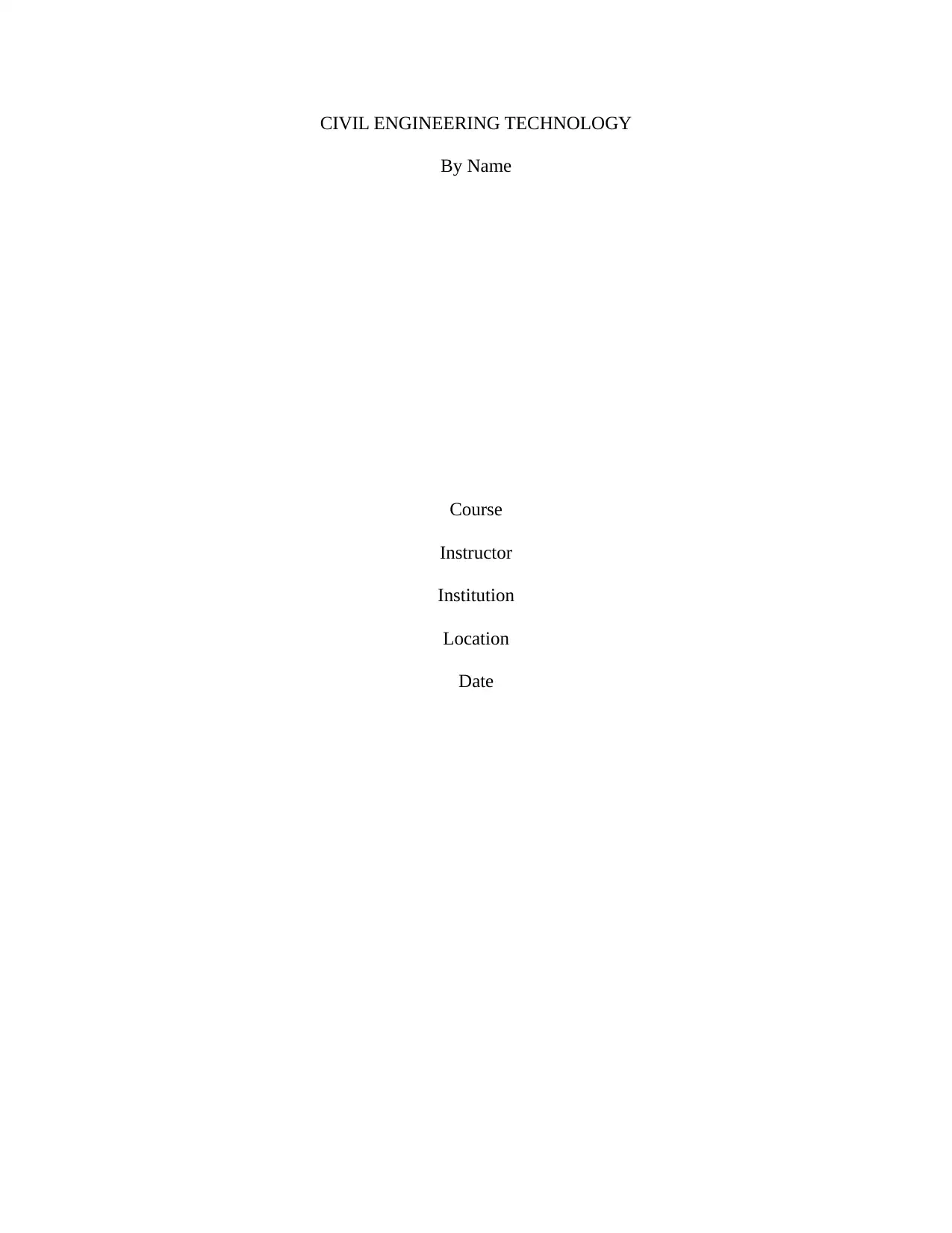
CIVIL ENGINEERING TECHNOLOGY
By Name
Course
Instructor
Institution
Location
Date
By Name
Course
Instructor
Institution
Location
Date
Paraphrase This Document
Need a fresh take? Get an instant paraphrase of this document with our AI Paraphraser
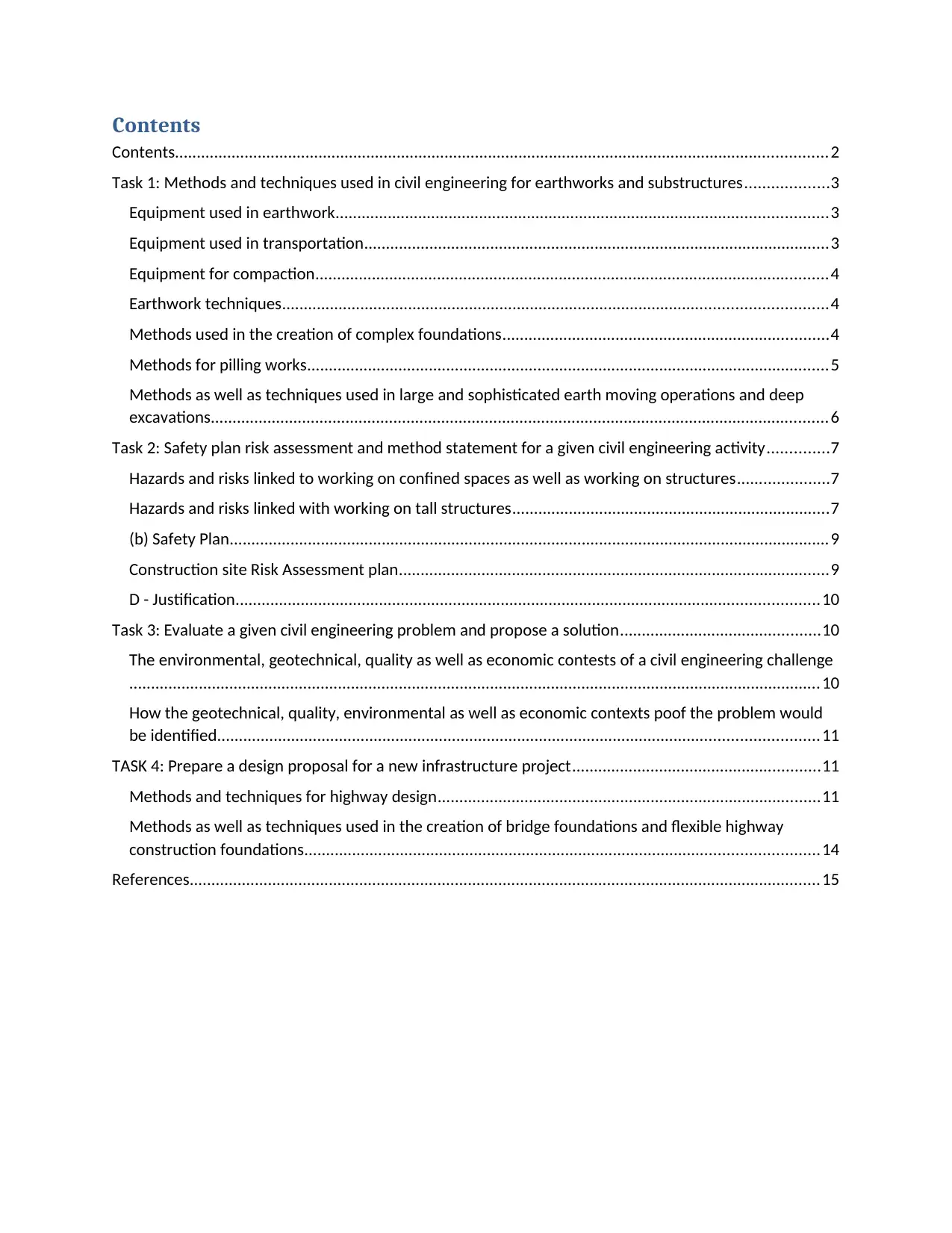
Contents
Contents......................................................................................................................................................2
Task 1: Methods and techniques used in civil engineering for earthworks and substructures...................3
Equipment used in earthwork.................................................................................................................3
Equipment used in transportation...........................................................................................................3
Equipment for compaction......................................................................................................................4
Earthwork techniques.............................................................................................................................4
Methods used in the creation of complex foundations...........................................................................4
Methods for pilling works........................................................................................................................5
Methods as well as techniques used in large and sophisticated earth moving operations and deep
excavations..............................................................................................................................................6
Task 2: Safety plan risk assessment and method statement for a given civil engineering activity..............7
Hazards and risks linked to working on confined spaces as well as working on structures.....................7
Hazards and risks linked with working on tall structures.........................................................................7
(b) Safety Plan..........................................................................................................................................9
Construction site Risk Assessment plan...................................................................................................9
D - Justification......................................................................................................................................10
Task 3: Evaluate a given civil engineering problem and propose a solution..............................................10
The environmental, geotechnical, quality as well as economic contests of a civil engineering challenge
...............................................................................................................................................................10
How the geotechnical, quality, environmental as well as economic contexts poof the problem would
be identified..........................................................................................................................................11
TASK 4: Prepare a design proposal for a new infrastructure project.........................................................11
Methods and techniques for highway design........................................................................................11
Methods as well as techniques used in the creation of bridge foundations and flexible highway
construction foundations......................................................................................................................14
References.................................................................................................................................................15
Contents......................................................................................................................................................2
Task 1: Methods and techniques used in civil engineering for earthworks and substructures...................3
Equipment used in earthwork.................................................................................................................3
Equipment used in transportation...........................................................................................................3
Equipment for compaction......................................................................................................................4
Earthwork techniques.............................................................................................................................4
Methods used in the creation of complex foundations...........................................................................4
Methods for pilling works........................................................................................................................5
Methods as well as techniques used in large and sophisticated earth moving operations and deep
excavations..............................................................................................................................................6
Task 2: Safety plan risk assessment and method statement for a given civil engineering activity..............7
Hazards and risks linked to working on confined spaces as well as working on structures.....................7
Hazards and risks linked with working on tall structures.........................................................................7
(b) Safety Plan..........................................................................................................................................9
Construction site Risk Assessment plan...................................................................................................9
D - Justification......................................................................................................................................10
Task 3: Evaluate a given civil engineering problem and propose a solution..............................................10
The environmental, geotechnical, quality as well as economic contests of a civil engineering challenge
...............................................................................................................................................................10
How the geotechnical, quality, environmental as well as economic contexts poof the problem would
be identified..........................................................................................................................................11
TASK 4: Prepare a design proposal for a new infrastructure project.........................................................11
Methods and techniques for highway design........................................................................................11
Methods as well as techniques used in the creation of bridge foundations and flexible highway
construction foundations......................................................................................................................14
References.................................................................................................................................................15
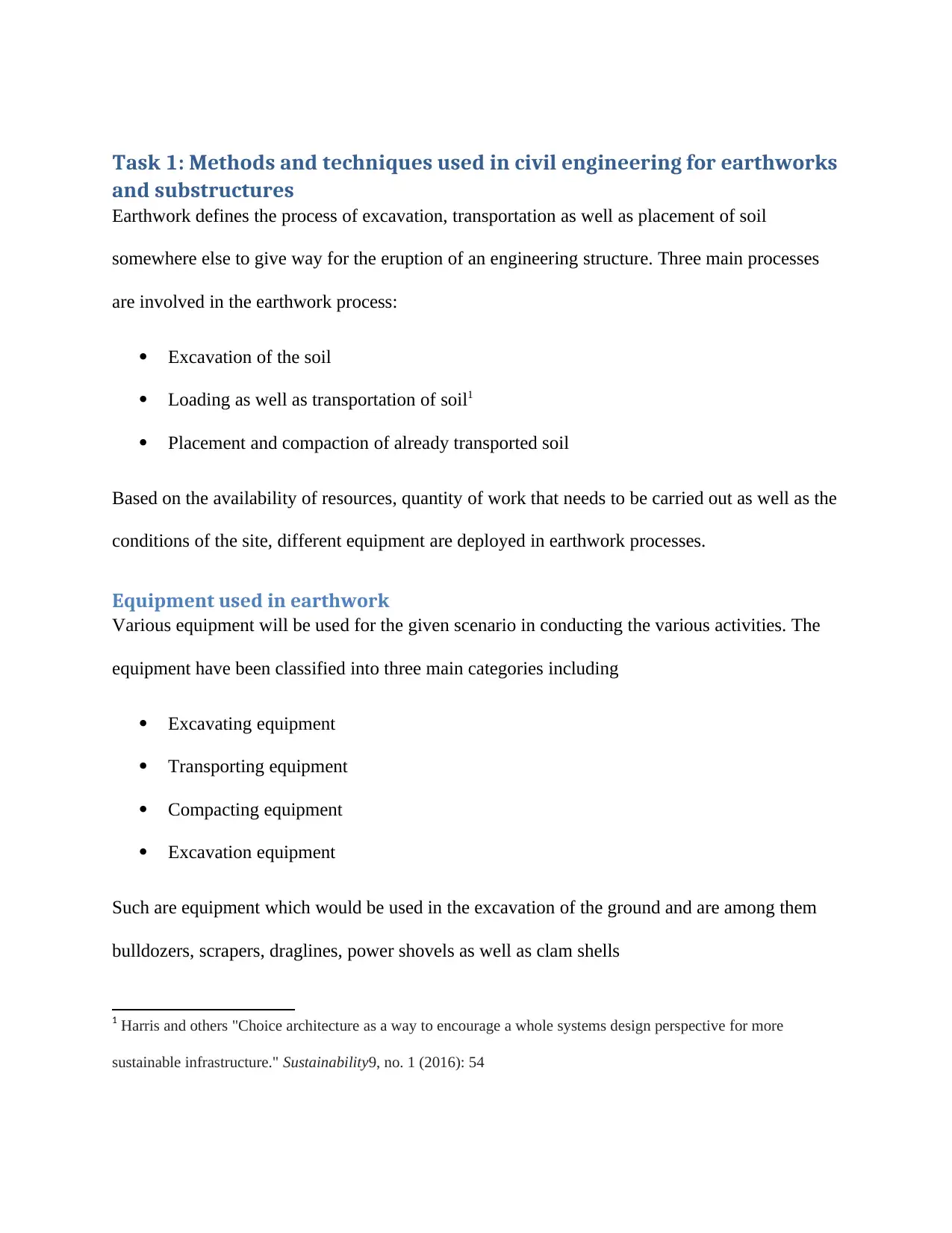
Task 1: Methods and techniques used in civil engineering for earthworks
and substructures
Earthwork defines the process of excavation, transportation as well as placement of soil
somewhere else to give way for the eruption of an engineering structure. Three main processes
are involved in the earthwork process:
Excavation of the soil
Loading as well as transportation of soil1
Placement and compaction of already transported soil
Based on the availability of resources, quantity of work that needs to be carried out as well as the
conditions of the site, different equipment are deployed in earthwork processes.
Equipment used in earthwork
Various equipment will be used for the given scenario in conducting the various activities. The
equipment have been classified into three main categories including
Excavating equipment
Transporting equipment
Compacting equipment
Excavation equipment
Such are equipment which would be used in the excavation of the ground and are among them
bulldozers, scrapers, draglines, power shovels as well as clam shells
1 Harris and others "Choice architecture as a way to encourage a whole systems design perspective for more
sustainable infrastructure." Sustainability9, no. 1 (2016): 54
and substructures
Earthwork defines the process of excavation, transportation as well as placement of soil
somewhere else to give way for the eruption of an engineering structure. Three main processes
are involved in the earthwork process:
Excavation of the soil
Loading as well as transportation of soil1
Placement and compaction of already transported soil
Based on the availability of resources, quantity of work that needs to be carried out as well as the
conditions of the site, different equipment are deployed in earthwork processes.
Equipment used in earthwork
Various equipment will be used for the given scenario in conducting the various activities. The
equipment have been classified into three main categories including
Excavating equipment
Transporting equipment
Compacting equipment
Excavation equipment
Such are equipment which would be used in the excavation of the ground and are among them
bulldozers, scrapers, draglines, power shovels as well as clam shells
1 Harris and others "Choice architecture as a way to encourage a whole systems design perspective for more
sustainable infrastructure." Sustainability9, no. 1 (2016): 54
⊘ This is a preview!⊘
Do you want full access?
Subscribe today to unlock all pages.

Trusted by 1+ million students worldwide
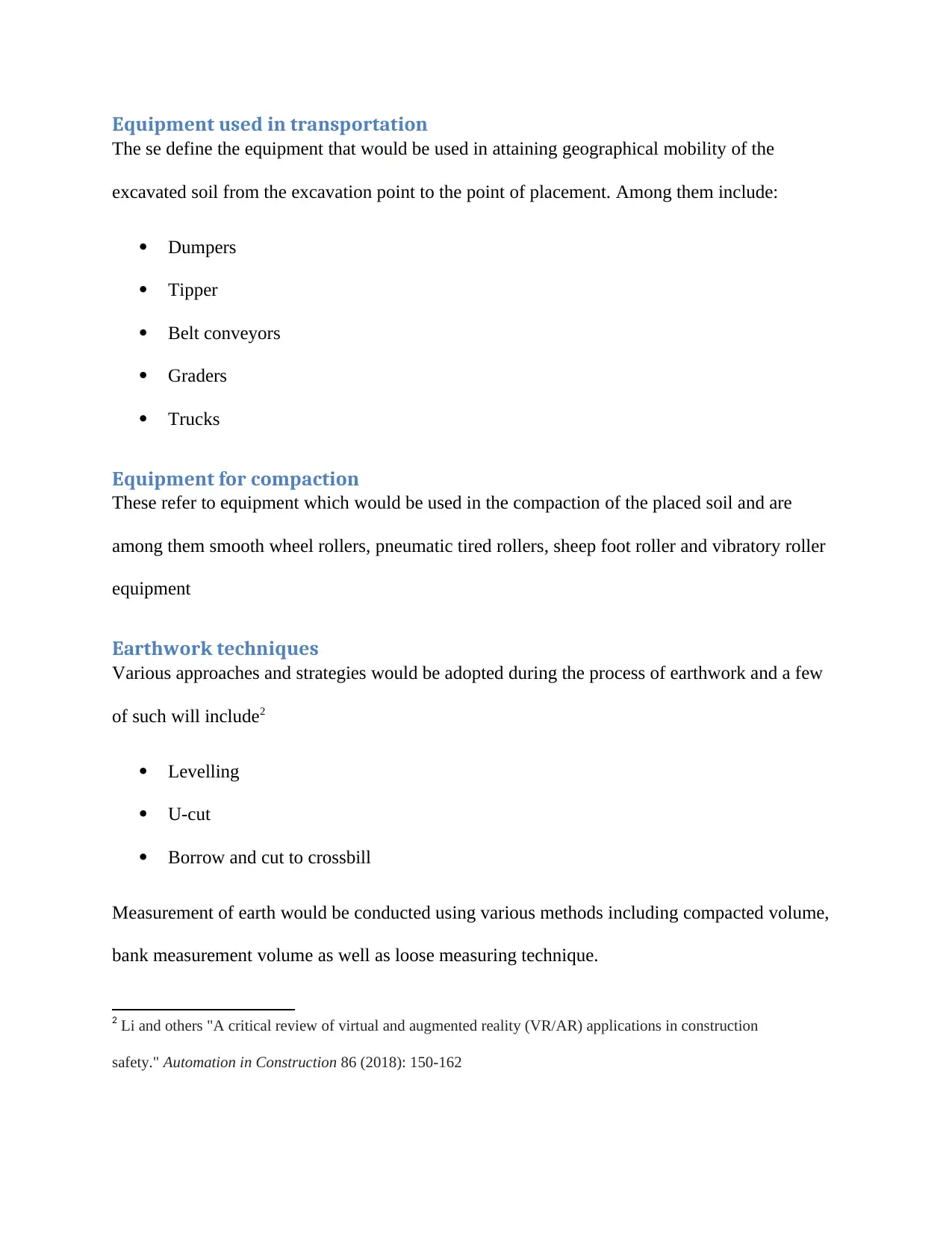
Equipment used in transportation
The se define the equipment that would be used in attaining geographical mobility of the
excavated soil from the excavation point to the point of placement. Among them include:
Dumpers
Tipper
Belt conveyors
Graders
Trucks
Equipment for compaction
These refer to equipment which would be used in the compaction of the placed soil and are
among them smooth wheel rollers, pneumatic tired rollers, sheep foot roller and vibratory roller
equipment
Earthwork techniques
Various approaches and strategies would be adopted during the process of earthwork and a few
of such will include2
Levelling
U-cut
Borrow and cut to crossbill
Measurement of earth would be conducted using various methods including compacted volume,
bank measurement volume as well as loose measuring technique.
2 Li and others "A critical review of virtual and augmented reality (VR/AR) applications in construction
safety." Automation in Construction 86 (2018): 150-162
The se define the equipment that would be used in attaining geographical mobility of the
excavated soil from the excavation point to the point of placement. Among them include:
Dumpers
Tipper
Belt conveyors
Graders
Trucks
Equipment for compaction
These refer to equipment which would be used in the compaction of the placed soil and are
among them smooth wheel rollers, pneumatic tired rollers, sheep foot roller and vibratory roller
equipment
Earthwork techniques
Various approaches and strategies would be adopted during the process of earthwork and a few
of such will include2
Levelling
U-cut
Borrow and cut to crossbill
Measurement of earth would be conducted using various methods including compacted volume,
bank measurement volume as well as loose measuring technique.
2 Li and others "A critical review of virtual and augmented reality (VR/AR) applications in construction
safety." Automation in Construction 86 (2018): 150-162
Paraphrase This Document
Need a fresh take? Get an instant paraphrase of this document with our AI Paraphraser
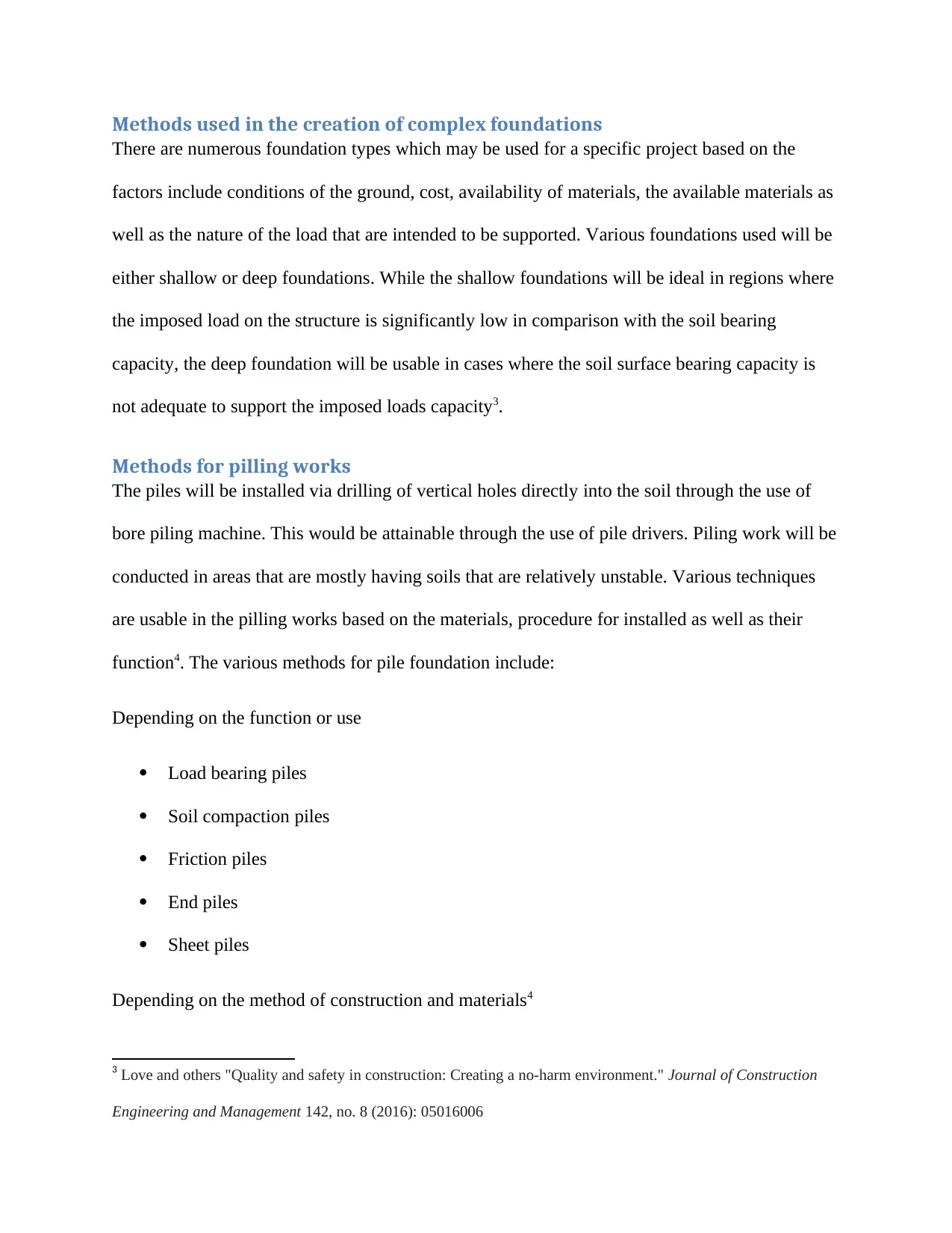
Methods used in the creation of complex foundations
There are numerous foundation types which may be used for a specific project based on the
factors include conditions of the ground, cost, availability of materials, the available materials as
well as the nature of the load that are intended to be supported. Various foundations used will be
either shallow or deep foundations. While the shallow foundations will be ideal in regions where
the imposed load on the structure is significantly low in comparison with the soil bearing
capacity, the deep foundation will be usable in cases where the soil surface bearing capacity is
not adequate to support the imposed loads capacity3.
Methods for pilling works
The piles will be installed via drilling of vertical holes directly into the soil through the use of
bore piling machine. This would be attainable through the use of pile drivers. Piling work will be
conducted in areas that are mostly having soils that are relatively unstable. Various techniques
are usable in the pilling works based on the materials, procedure for installed as well as their
function4. The various methods for pile foundation include:
Depending on the function or use
Load bearing piles
Soil compaction piles
Friction piles
End piles
Sheet piles
Depending on the method of construction and materials4
3 Love and others "Quality and safety in construction: Creating a no-harm environment." Journal of Construction
Engineering and Management 142, no. 8 (2016): 05016006
There are numerous foundation types which may be used for a specific project based on the
factors include conditions of the ground, cost, availability of materials, the available materials as
well as the nature of the load that are intended to be supported. Various foundations used will be
either shallow or deep foundations. While the shallow foundations will be ideal in regions where
the imposed load on the structure is significantly low in comparison with the soil bearing
capacity, the deep foundation will be usable in cases where the soil surface bearing capacity is
not adequate to support the imposed loads capacity3.
Methods for pilling works
The piles will be installed via drilling of vertical holes directly into the soil through the use of
bore piling machine. This would be attainable through the use of pile drivers. Piling work will be
conducted in areas that are mostly having soils that are relatively unstable. Various techniques
are usable in the pilling works based on the materials, procedure for installed as well as their
function4. The various methods for pile foundation include:
Depending on the function or use
Load bearing piles
Soil compaction piles
Friction piles
End piles
Sheet piles
Depending on the method of construction and materials4
3 Love and others "Quality and safety in construction: Creating a no-harm environment." Journal of Construction
Engineering and Management 142, no. 8 (2016): 05016006
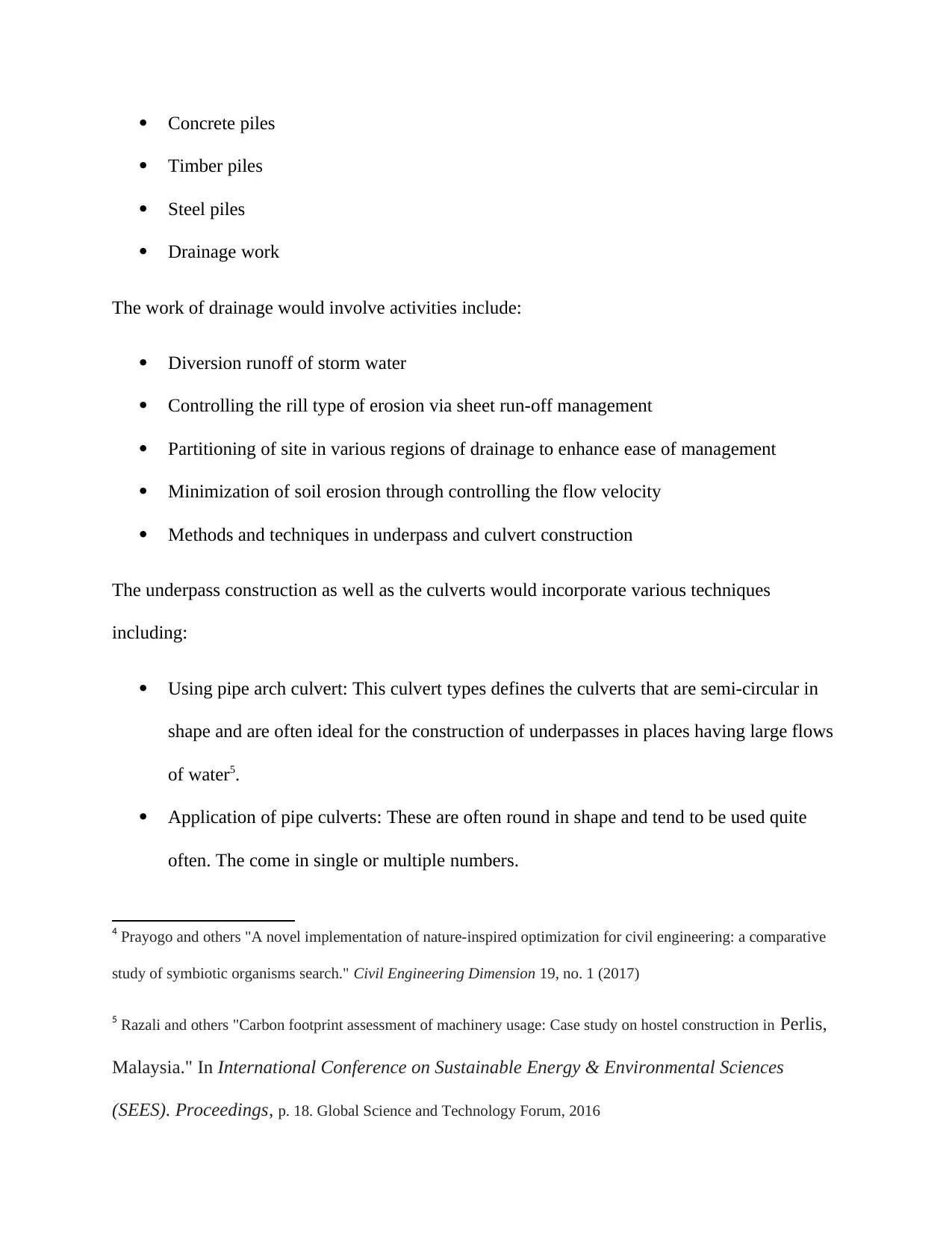
Concrete piles
Timber piles
Steel piles
Drainage work
The work of drainage would involve activities include:
Diversion runoff of storm water
Controlling the rill type of erosion via sheet run-off management
Partitioning of site in various regions of drainage to enhance ease of management
Minimization of soil erosion through controlling the flow velocity
Methods and techniques in underpass and culvert construction
The underpass construction as well as the culverts would incorporate various techniques
including:
Using pipe arch culvert: This culvert types defines the culverts that are semi-circular in
shape and are often ideal for the construction of underpasses in places having large flows
of water5.
Application of pipe culverts: These are often round in shape and tend to be used quite
often. The come in single or multiple numbers.
4 Prayogo and others "A novel implementation of nature-inspired optimization for civil engineering: a comparative
study of symbiotic organisms search." Civil Engineering Dimension 19, no. 1 (2017)
5 Razali and others "Carbon footprint assessment of machinery usage: Case study on hostel construction in Perlis,
Malaysia." In International Conference on Sustainable Energy & Environmental Sciences
(SEES). Proceedings, p. 18. Global Science and Technology Forum, 2016
Timber piles
Steel piles
Drainage work
The work of drainage would involve activities include:
Diversion runoff of storm water
Controlling the rill type of erosion via sheet run-off management
Partitioning of site in various regions of drainage to enhance ease of management
Minimization of soil erosion through controlling the flow velocity
Methods and techniques in underpass and culvert construction
The underpass construction as well as the culverts would incorporate various techniques
including:
Using pipe arch culvert: This culvert types defines the culverts that are semi-circular in
shape and are often ideal for the construction of underpasses in places having large flows
of water5.
Application of pipe culverts: These are often round in shape and tend to be used quite
often. The come in single or multiple numbers.
4 Prayogo and others "A novel implementation of nature-inspired optimization for civil engineering: a comparative
study of symbiotic organisms search." Civil Engineering Dimension 19, no. 1 (2017)
5 Razali and others "Carbon footprint assessment of machinery usage: Case study on hostel construction in Perlis,
Malaysia." In International Conference on Sustainable Energy & Environmental Sciences
(SEES). Proceedings, p. 18. Global Science and Technology Forum, 2016
⊘ This is a preview!⊘
Do you want full access?
Subscribe today to unlock all pages.

Trusted by 1+ million students worldwide
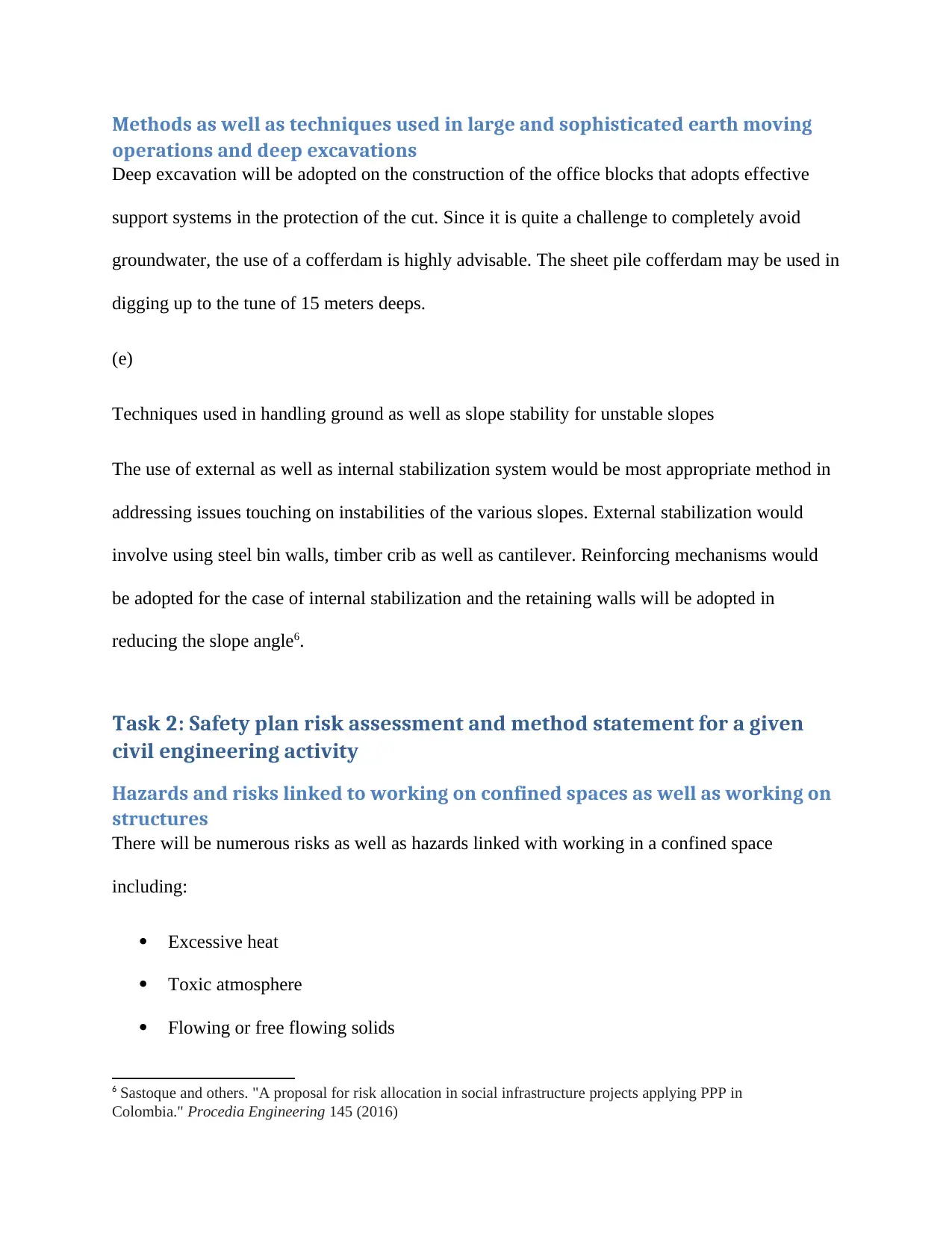
Methods as well as techniques used in large and sophisticated earth moving
operations and deep excavations
Deep excavation will be adopted on the construction of the office blocks that adopts effective
support systems in the protection of the cut. Since it is quite a challenge to completely avoid
groundwater, the use of a cofferdam is highly advisable. The sheet pile cofferdam may be used in
digging up to the tune of 15 meters deeps.
(e)
Techniques used in handling ground as well as slope stability for unstable slopes
The use of external as well as internal stabilization system would be most appropriate method in
addressing issues touching on instabilities of the various slopes. External stabilization would
involve using steel bin walls, timber crib as well as cantilever. Reinforcing mechanisms would
be adopted for the case of internal stabilization and the retaining walls will be adopted in
reducing the slope angle6.
Task 2: Safety plan risk assessment and method statement for a given
civil engineering activity
Hazards and risks linked to working on confined spaces as well as working on
structures
There will be numerous risks as well as hazards linked with working in a confined space
including:
Excessive heat
Toxic atmosphere
Flowing or free flowing solids
6 Sastoque and others. "A proposal for risk allocation in social infrastructure projects applying PPP in
Colombia." Procedia Engineering 145 (2016)
operations and deep excavations
Deep excavation will be adopted on the construction of the office blocks that adopts effective
support systems in the protection of the cut. Since it is quite a challenge to completely avoid
groundwater, the use of a cofferdam is highly advisable. The sheet pile cofferdam may be used in
digging up to the tune of 15 meters deeps.
(e)
Techniques used in handling ground as well as slope stability for unstable slopes
The use of external as well as internal stabilization system would be most appropriate method in
addressing issues touching on instabilities of the various slopes. External stabilization would
involve using steel bin walls, timber crib as well as cantilever. Reinforcing mechanisms would
be adopted for the case of internal stabilization and the retaining walls will be adopted in
reducing the slope angle6.
Task 2: Safety plan risk assessment and method statement for a given
civil engineering activity
Hazards and risks linked to working on confined spaces as well as working on
structures
There will be numerous risks as well as hazards linked with working in a confined space
including:
Excessive heat
Toxic atmosphere
Flowing or free flowing solids
6 Sastoque and others. "A proposal for risk allocation in social infrastructure projects applying PPP in
Colombia." Procedia Engineering 145 (2016)
Paraphrase This Document
Need a fresh take? Get an instant paraphrase of this document with our AI Paraphraser
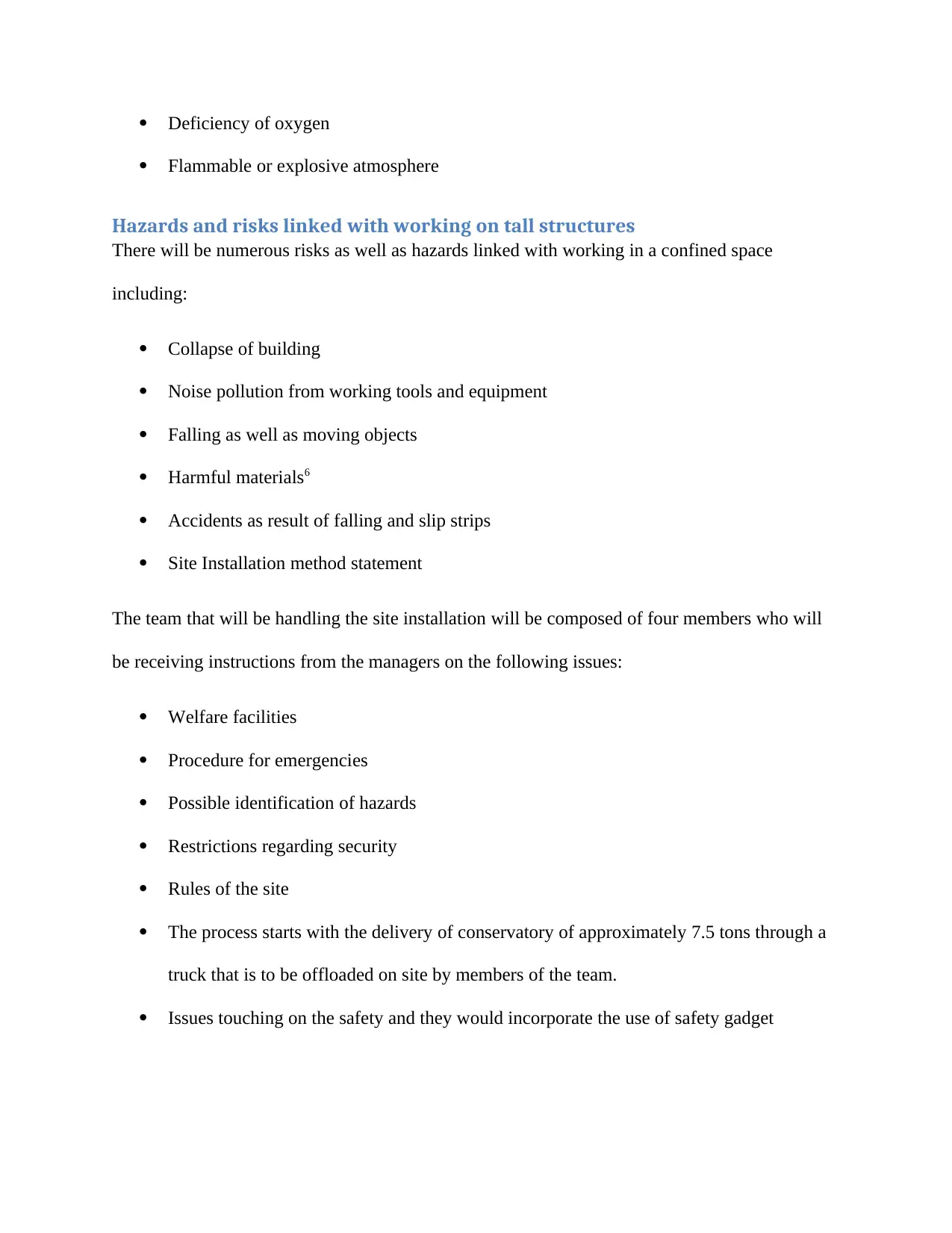
Deficiency of oxygen
Flammable or explosive atmosphere
Hazards and risks linked with working on tall structures
There will be numerous risks as well as hazards linked with working in a confined space
including:
Collapse of building
Noise pollution from working tools and equipment
Falling as well as moving objects
Harmful materials6
Accidents as result of falling and slip strips
Site Installation method statement
The team that will be handling the site installation will be composed of four members who will
be receiving instructions from the managers on the following issues:
Welfare facilities
Procedure for emergencies
Possible identification of hazards
Restrictions regarding security
Rules of the site
The process starts with the delivery of conservatory of approximately 7.5 tons through a
truck that is to be offloaded on site by members of the team.
Issues touching on the safety and they would incorporate the use of safety gadget
Flammable or explosive atmosphere
Hazards and risks linked with working on tall structures
There will be numerous risks as well as hazards linked with working in a confined space
including:
Collapse of building
Noise pollution from working tools and equipment
Falling as well as moving objects
Harmful materials6
Accidents as result of falling and slip strips
Site Installation method statement
The team that will be handling the site installation will be composed of four members who will
be receiving instructions from the managers on the following issues:
Welfare facilities
Procedure for emergencies
Possible identification of hazards
Restrictions regarding security
Rules of the site
The process starts with the delivery of conservatory of approximately 7.5 tons through a
truck that is to be offloaded on site by members of the team.
Issues touching on the safety and they would incorporate the use of safety gadget
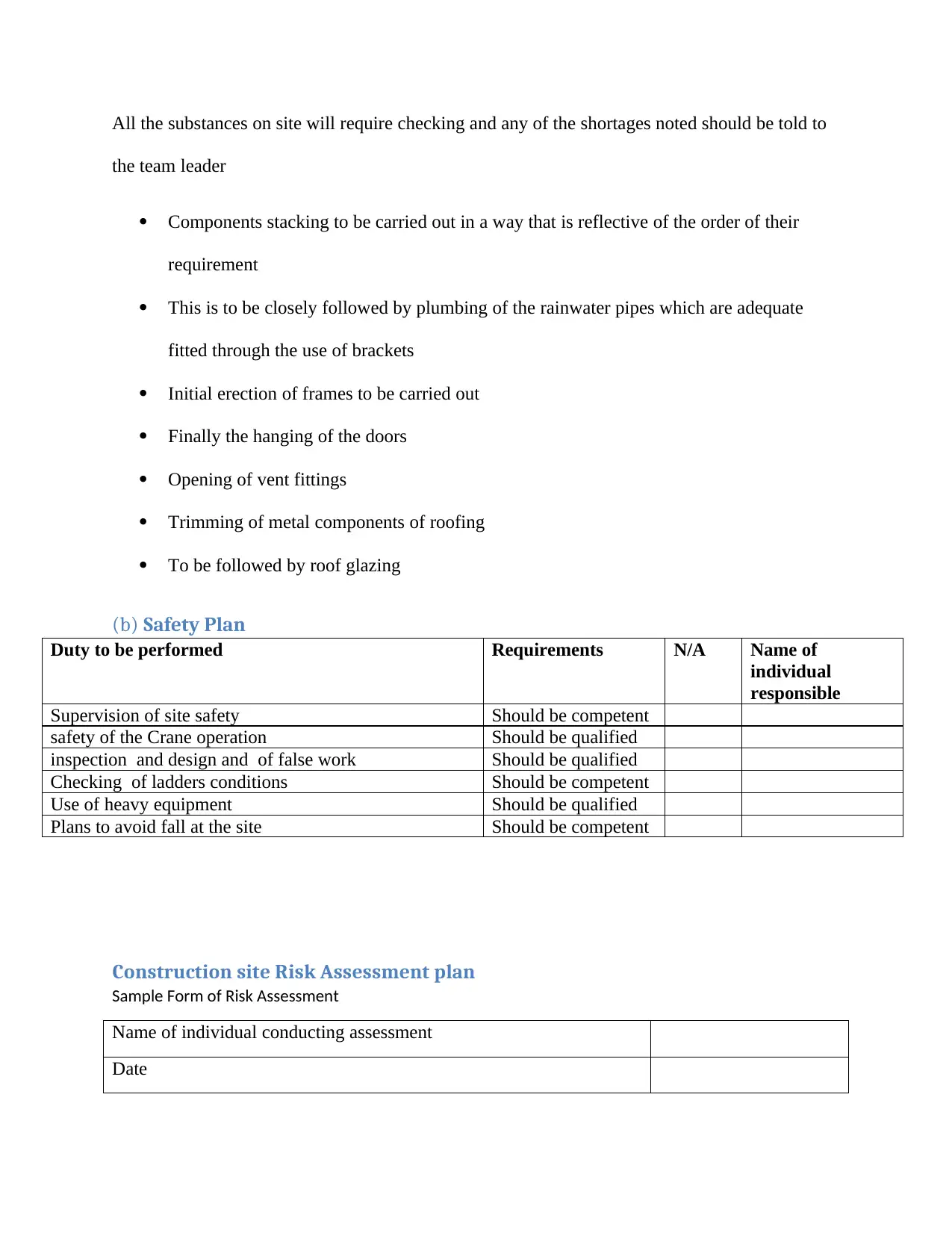
All the substances on site will require checking and any of the shortages noted should be told to
the team leader
Components stacking to be carried out in a way that is reflective of the order of their
requirement
This is to be closely followed by plumbing of the rainwater pipes which are adequate
fitted through the use of brackets
Initial erection of frames to be carried out
Finally the hanging of the doors
Opening of vent fittings
Trimming of metal components of roofing
To be followed by roof glazing
(b) Safety Plan
Duty to be performed Requirements N/A Name of
individual
responsible
Supervision of site safety Should be competent
safety of the Crane operation Should be qualified
inspection and design and of false work Should be qualified
Checking of ladders conditions Should be competent
Use of heavy equipment Should be qualified
Plans to avoid fall at the site Should be competent
Construction site Risk Assessment plan
Sample Form of Risk Assessment
Name of individual conducting assessment
Date
the team leader
Components stacking to be carried out in a way that is reflective of the order of their
requirement
This is to be closely followed by plumbing of the rainwater pipes which are adequate
fitted through the use of brackets
Initial erection of frames to be carried out
Finally the hanging of the doors
Opening of vent fittings
Trimming of metal components of roofing
To be followed by roof glazing
(b) Safety Plan
Duty to be performed Requirements N/A Name of
individual
responsible
Supervision of site safety Should be competent
safety of the Crane operation Should be qualified
inspection and design and of false work Should be qualified
Checking of ladders conditions Should be competent
Use of heavy equipment Should be qualified
Plans to avoid fall at the site Should be competent
Construction site Risk Assessment plan
Sample Form of Risk Assessment
Name of individual conducting assessment
Date
⊘ This is a preview!⊘
Do you want full access?
Subscribe today to unlock all pages.

Trusted by 1+ million students worldwide
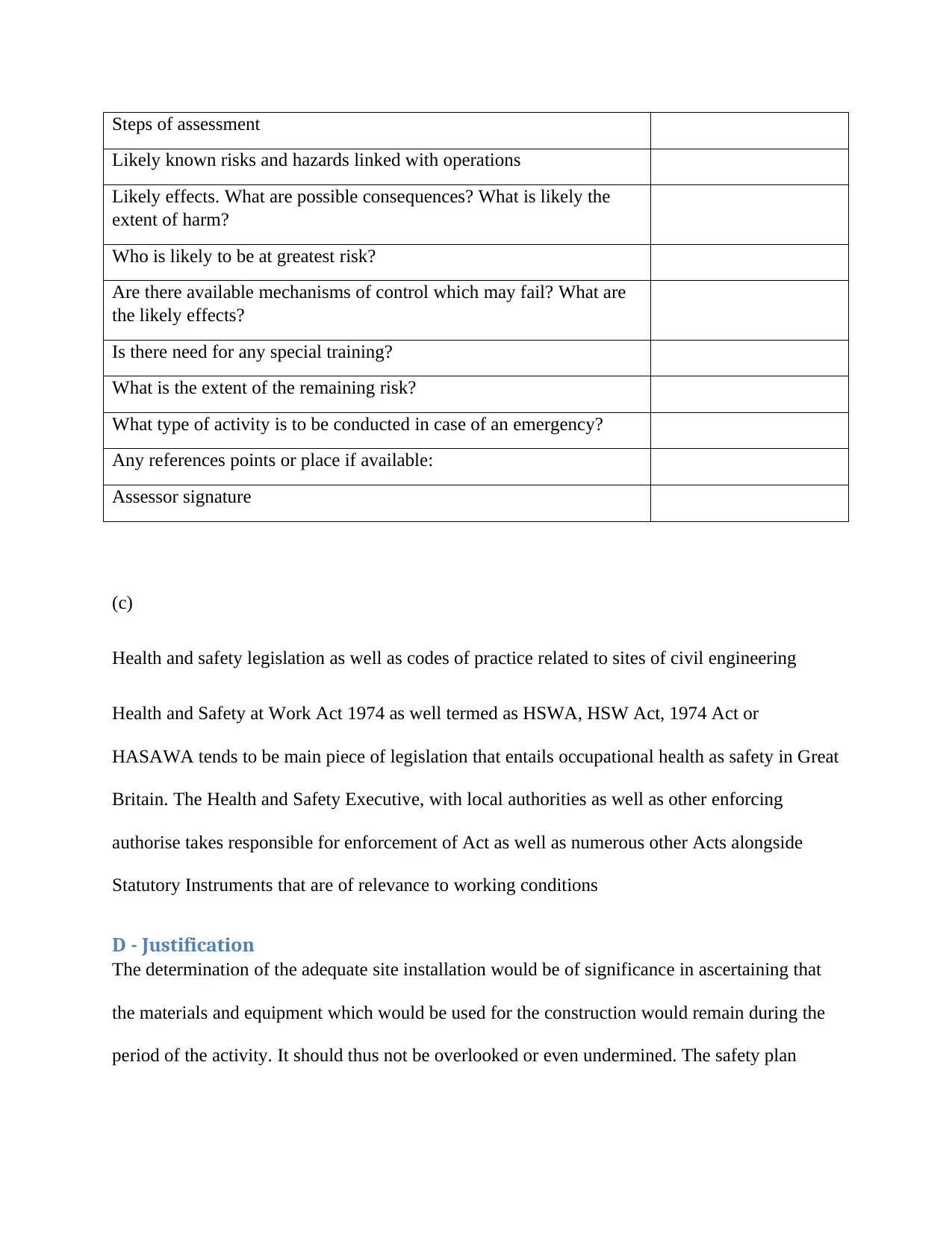
Steps of assessment
Likely known risks and hazards linked with operations
Likely effects. What are possible consequences? What is likely the
extent of harm?
Who is likely to be at greatest risk?
Are there available mechanisms of control which may fail? What are
the likely effects?
Is there need for any special training?
What is the extent of the remaining risk?
What type of activity is to be conducted in case of an emergency?
Any references points or place if available:
Assessor signature
(c)
Health and safety legislation as well as codes of practice related to sites of civil engineering
Health and Safety at Work Act 1974 as well termed as HSWA, HSW Act, 1974 Act or
HASAWA tends to be main piece of legislation that entails occupational health as safety in Great
Britain. The Health and Safety Executive, with local authorities as well as other enforcing
authorise takes responsible for enforcement of Act as well as numerous other Acts alongside
Statutory Instruments that are of relevance to working conditions
D - Justification
The determination of the adequate site installation would be of significance in ascertaining that
the materials and equipment which would be used for the construction would remain during the
period of the activity. It should thus not be overlooked or even undermined. The safety plan
Likely known risks and hazards linked with operations
Likely effects. What are possible consequences? What is likely the
extent of harm?
Who is likely to be at greatest risk?
Are there available mechanisms of control which may fail? What are
the likely effects?
Is there need for any special training?
What is the extent of the remaining risk?
What type of activity is to be conducted in case of an emergency?
Any references points or place if available:
Assessor signature
(c)
Health and safety legislation as well as codes of practice related to sites of civil engineering
Health and Safety at Work Act 1974 as well termed as HSWA, HSW Act, 1974 Act or
HASAWA tends to be main piece of legislation that entails occupational health as safety in Great
Britain. The Health and Safety Executive, with local authorities as well as other enforcing
authorise takes responsible for enforcement of Act as well as numerous other Acts alongside
Statutory Instruments that are of relevance to working conditions
D - Justification
The determination of the adequate site installation would be of significance in ascertaining that
the materials and equipment which would be used for the construction would remain during the
period of the activity. It should thus not be overlooked or even undermined. The safety plan
Paraphrase This Document
Need a fresh take? Get an instant paraphrase of this document with our AI Paraphraser
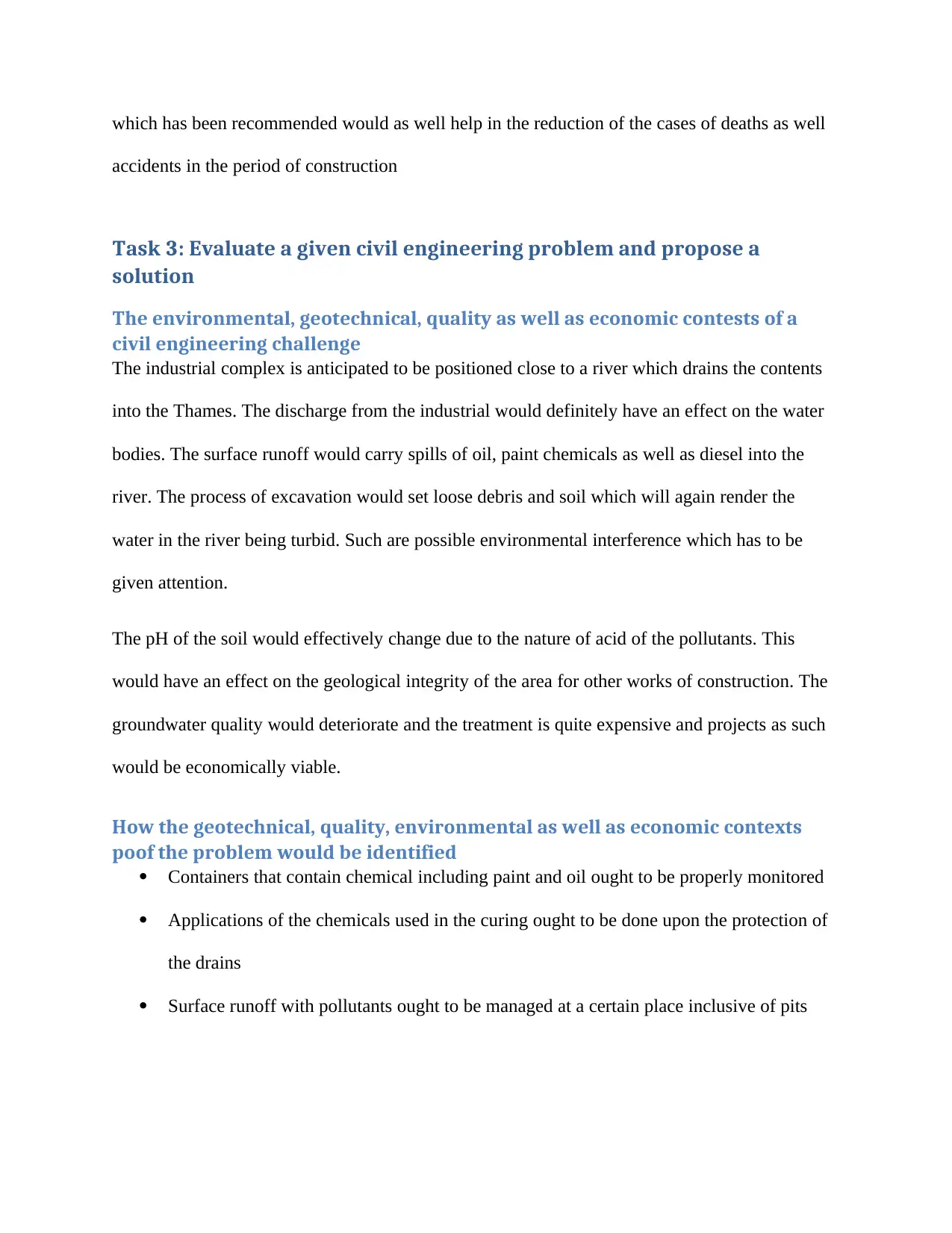
which has been recommended would as well help in the reduction of the cases of deaths as well
accidents in the period of construction
Task 3: Evaluate a given civil engineering problem and propose a
solution
The environmental, geotechnical, quality as well as economic contests of a
civil engineering challenge
The industrial complex is anticipated to be positioned close to a river which drains the contents
into the Thames. The discharge from the industrial would definitely have an effect on the water
bodies. The surface runoff would carry spills of oil, paint chemicals as well as diesel into the
river. The process of excavation would set loose debris and soil which will again render the
water in the river being turbid. Such are possible environmental interference which has to be
given attention.
The pH of the soil would effectively change due to the nature of acid of the pollutants. This
would have an effect on the geological integrity of the area for other works of construction. The
groundwater quality would deteriorate and the treatment is quite expensive and projects as such
would be economically viable.
How the geotechnical, quality, environmental as well as economic contexts
poof the problem would be identified
Containers that contain chemical including paint and oil ought to be properly monitored
Applications of the chemicals used in the curing ought to be done upon the protection of
the drains
Surface runoff with pollutants ought to be managed at a certain place inclusive of pits
accidents in the period of construction
Task 3: Evaluate a given civil engineering problem and propose a
solution
The environmental, geotechnical, quality as well as economic contests of a
civil engineering challenge
The industrial complex is anticipated to be positioned close to a river which drains the contents
into the Thames. The discharge from the industrial would definitely have an effect on the water
bodies. The surface runoff would carry spills of oil, paint chemicals as well as diesel into the
river. The process of excavation would set loose debris and soil which will again render the
water in the river being turbid. Such are possible environmental interference which has to be
given attention.
The pH of the soil would effectively change due to the nature of acid of the pollutants. This
would have an effect on the geological integrity of the area for other works of construction. The
groundwater quality would deteriorate and the treatment is quite expensive and projects as such
would be economically viable.
How the geotechnical, quality, environmental as well as economic contexts
poof the problem would be identified
Containers that contain chemical including paint and oil ought to be properly monitored
Applications of the chemicals used in the curing ought to be done upon the protection of
the drains
Surface runoff with pollutants ought to be managed at a certain place inclusive of pits
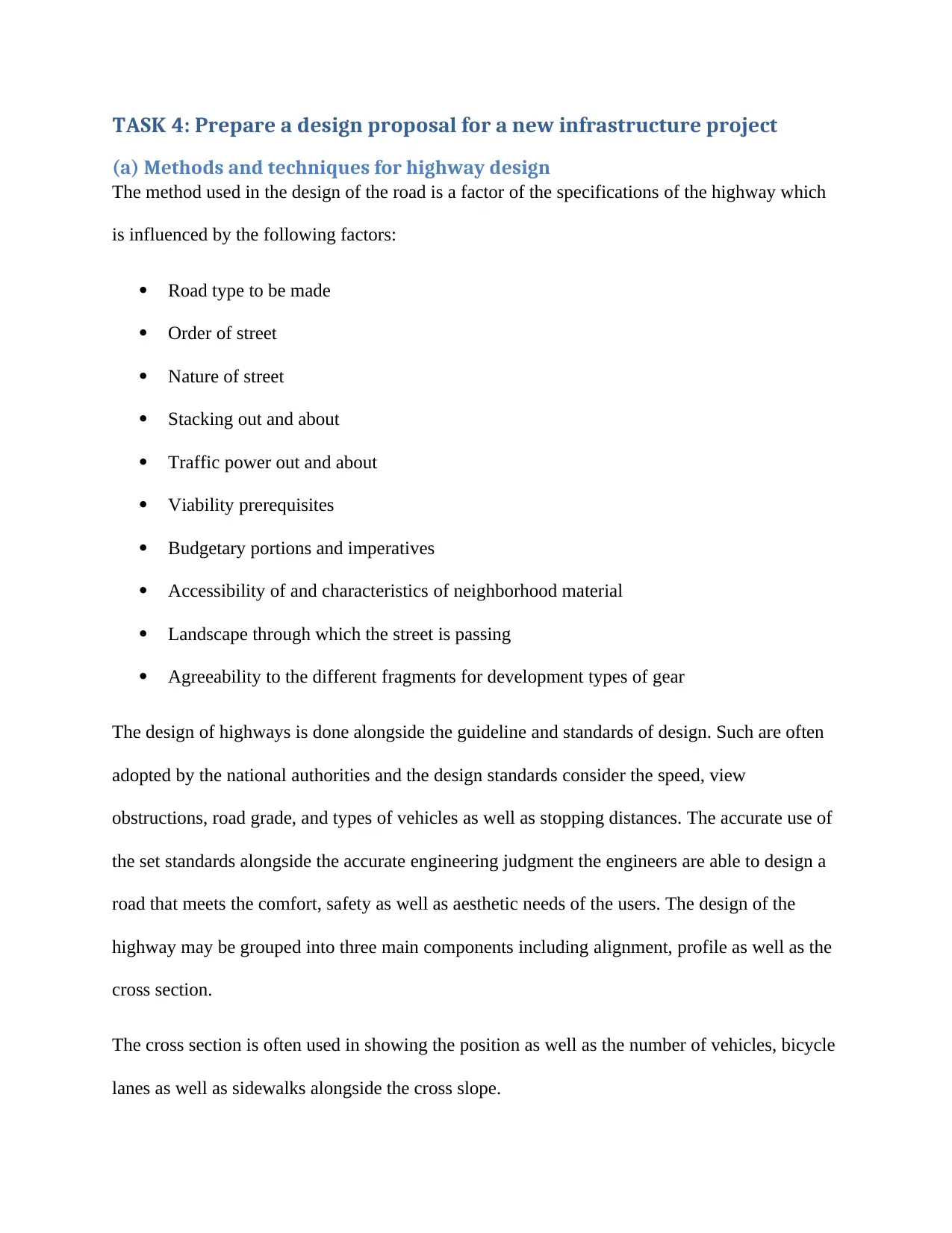
TASK 4: Prepare a design proposal for a new infrastructure project
(a) Methods and techniques for highway design
The method used in the design of the road is a factor of the specifications of the highway which
is influenced by the following factors:
Road type to be made
Order of street
Nature of street
Stacking out and about
Traffic power out and about
Viability prerequisites
Budgetary portions and imperatives
Accessibility of and characteristics of neighborhood material
Landscape through which the street is passing
Agreeability to the different fragments for development types of gear
The design of highways is done alongside the guideline and standards of design. Such are often
adopted by the national authorities and the design standards consider the speed, view
obstructions, road grade, and types of vehicles as well as stopping distances. The accurate use of
the set standards alongside the accurate engineering judgment the engineers are able to design a
road that meets the comfort, safety as well as aesthetic needs of the users. The design of the
highway may be grouped into three main components including alignment, profile as well as the
cross section.
The cross section is often used in showing the position as well as the number of vehicles, bicycle
lanes as well as sidewalks alongside the cross slope.
(a) Methods and techniques for highway design
The method used in the design of the road is a factor of the specifications of the highway which
is influenced by the following factors:
Road type to be made
Order of street
Nature of street
Stacking out and about
Traffic power out and about
Viability prerequisites
Budgetary portions and imperatives
Accessibility of and characteristics of neighborhood material
Landscape through which the street is passing
Agreeability to the different fragments for development types of gear
The design of highways is done alongside the guideline and standards of design. Such are often
adopted by the national authorities and the design standards consider the speed, view
obstructions, road grade, and types of vehicles as well as stopping distances. The accurate use of
the set standards alongside the accurate engineering judgment the engineers are able to design a
road that meets the comfort, safety as well as aesthetic needs of the users. The design of the
highway may be grouped into three main components including alignment, profile as well as the
cross section.
The cross section is often used in showing the position as well as the number of vehicles, bicycle
lanes as well as sidewalks alongside the cross slope.
⊘ This is a preview!⊘
Do you want full access?
Subscribe today to unlock all pages.

Trusted by 1+ million students worldwide
1 out of 16
Related Documents
Your All-in-One AI-Powered Toolkit for Academic Success.
+13062052269
info@desklib.com
Available 24*7 on WhatsApp / Email
![[object Object]](/_next/static/media/star-bottom.7253800d.svg)
Unlock your academic potential
Copyright © 2020–2025 A2Z Services. All Rights Reserved. Developed and managed by ZUCOL.

